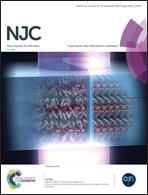A high-temperature molecular ferroelastic phase transition and switchable dielectric response in the trimethylbromomethylammonium salt [C4H11NBr] [PF6]†
Abstract
By introducing halogens to 16 symmetric tetramethylammonium, one new molecular ferroelastic compound [TMBMA] [PF6] (1) (TMBMA = trimethylbromomethylammonium) was successfully synthesized. Differential scanning calorimetry (DSC) measurements demonstrated that 1 underwent a typical first-order phase transition at ca. 380 K with a large thermal hysteresis of 30 K. Single crystal X-ray diffraction data, the variable-temperature powder X-ray diffraction (PXRD) patterns and the complex domain-wall orientations suggested that the phase transition from monoclinic (P21/c) to cubic (Pm![[3 with combining macron]](https://www.rsc.org/images/entities/char_0033_0304.gif) m) belongs to a ferroelastic phase transition with an Aizu notation of m
m) belongs to a ferroelastic phase transition with an Aizu notation of m![[3 with combining macron]](https://www.rsc.org/images/entities/char_0033_0304.gif) mF2/m. Dielectric studies show that 1 exhibits distinct switchable dielectric behavior and satisfactory thermal stability, revealing its potential application in dielectric switches. As expected, the TMBMA cations bearing an ordered–disordered motion turn out to be crucial in the generation of the ferroelastic phase transition. Therefore, this molecular design strategy of introducing halogens to tetraalkylammoniums can not only reduce the symmetry of the tetraalkylammonium molecules at room temperature, but can also maintain the highly disordered characteristics at high temperatures. This provides an efficient route for us to find new molecular ferroelastics and dielectric switches.
mF2/m. Dielectric studies show that 1 exhibits distinct switchable dielectric behavior and satisfactory thermal stability, revealing its potential application in dielectric switches. As expected, the TMBMA cations bearing an ordered–disordered motion turn out to be crucial in the generation of the ferroelastic phase transition. Therefore, this molecular design strategy of introducing halogens to tetraalkylammoniums can not only reduce the symmetry of the tetraalkylammonium molecules at room temperature, but can also maintain the highly disordered characteristics at high temperatures. This provides an efficient route for us to find new molecular ferroelastics and dielectric switches.
![Graphical abstract: A high-temperature molecular ferroelastic phase transition and switchable dielectric response in the trimethylbromomethylammonium salt [C4H11NBr] [PF6]](/en/Image/Get?imageInfo.ImageType=GA&imageInfo.ImageIdentifier.ManuscriptID=C8NJ02645A&imageInfo.ImageIdentifier.Year=2018)


 Please wait while we load your content...
Please wait while we load your content...